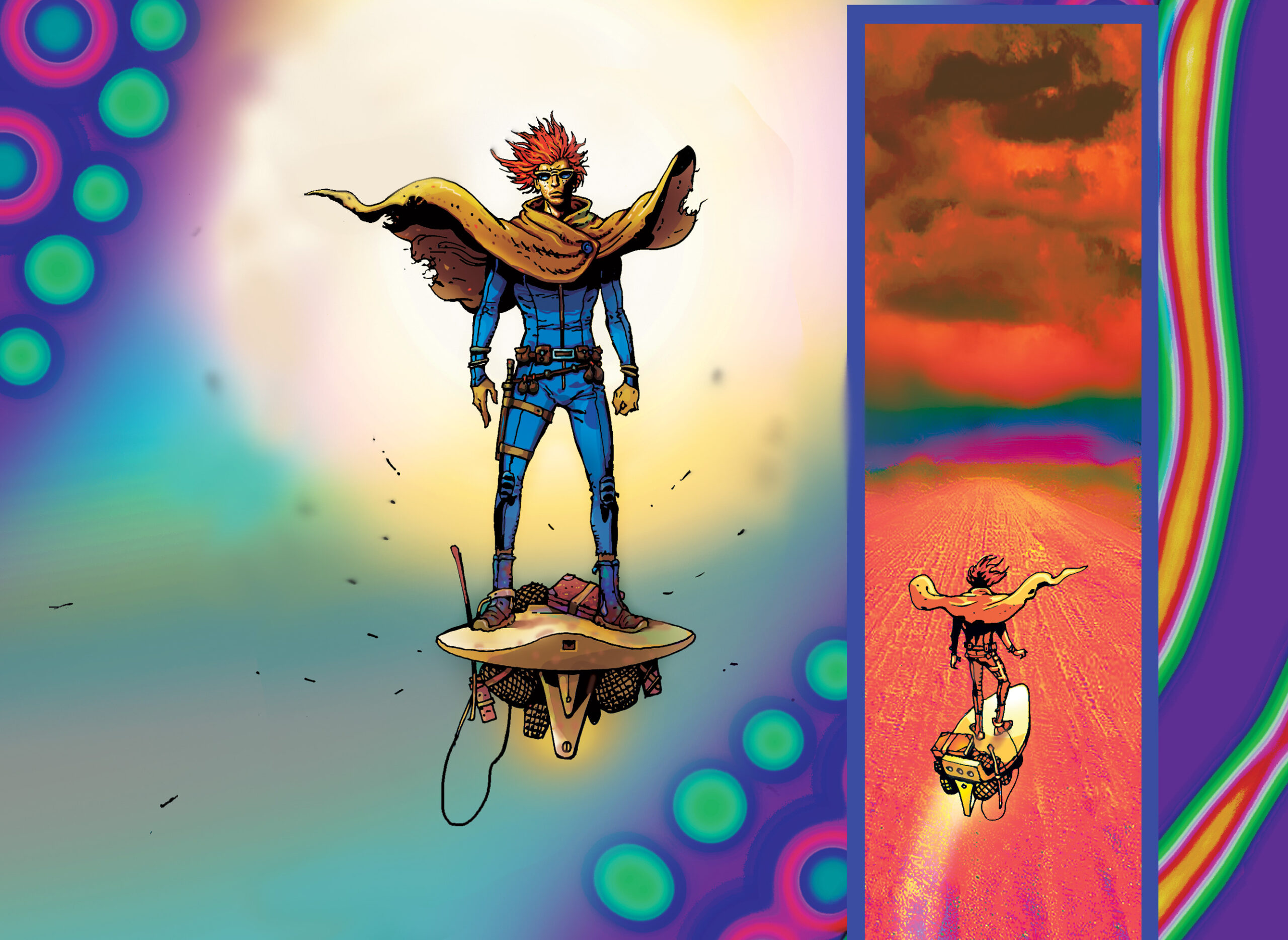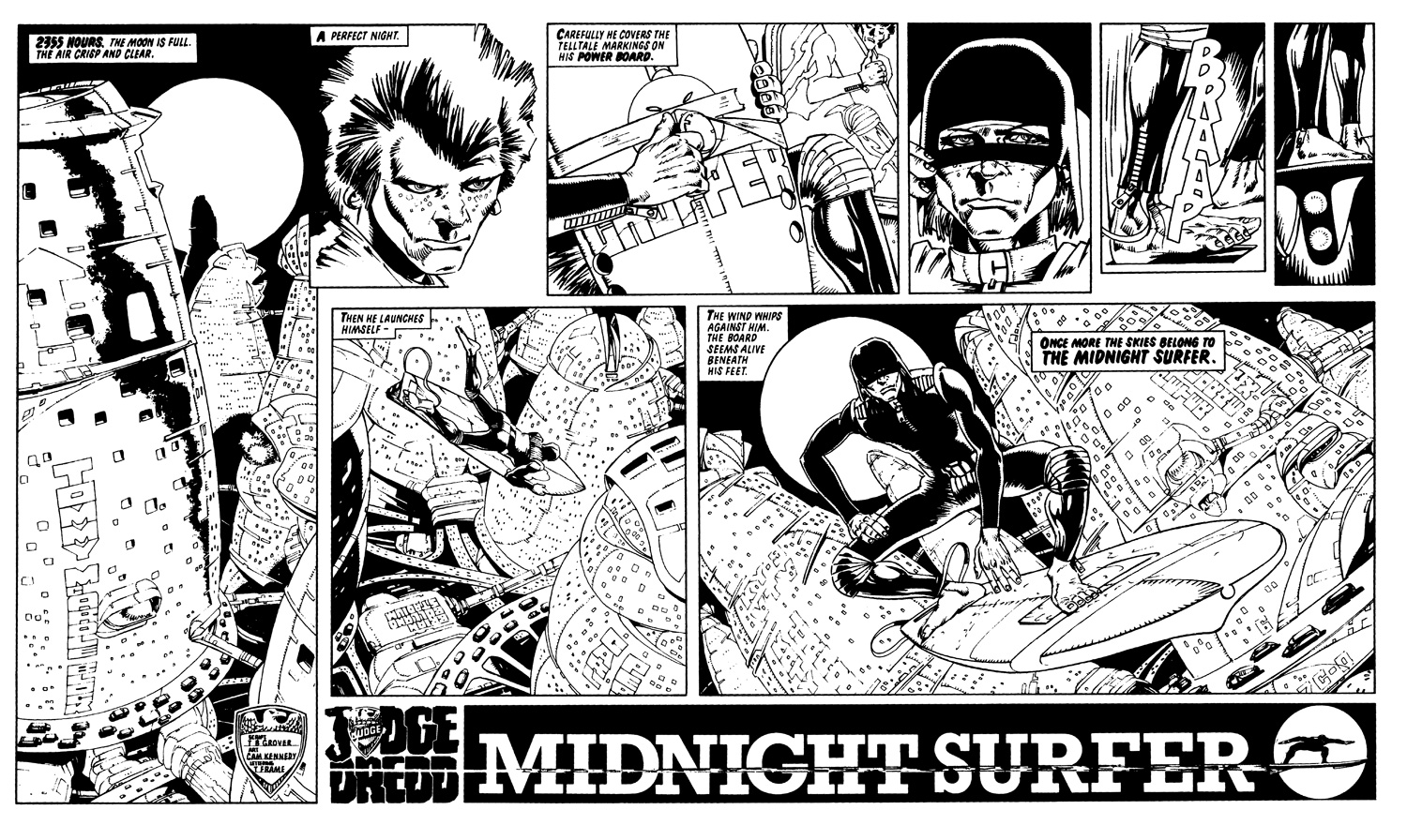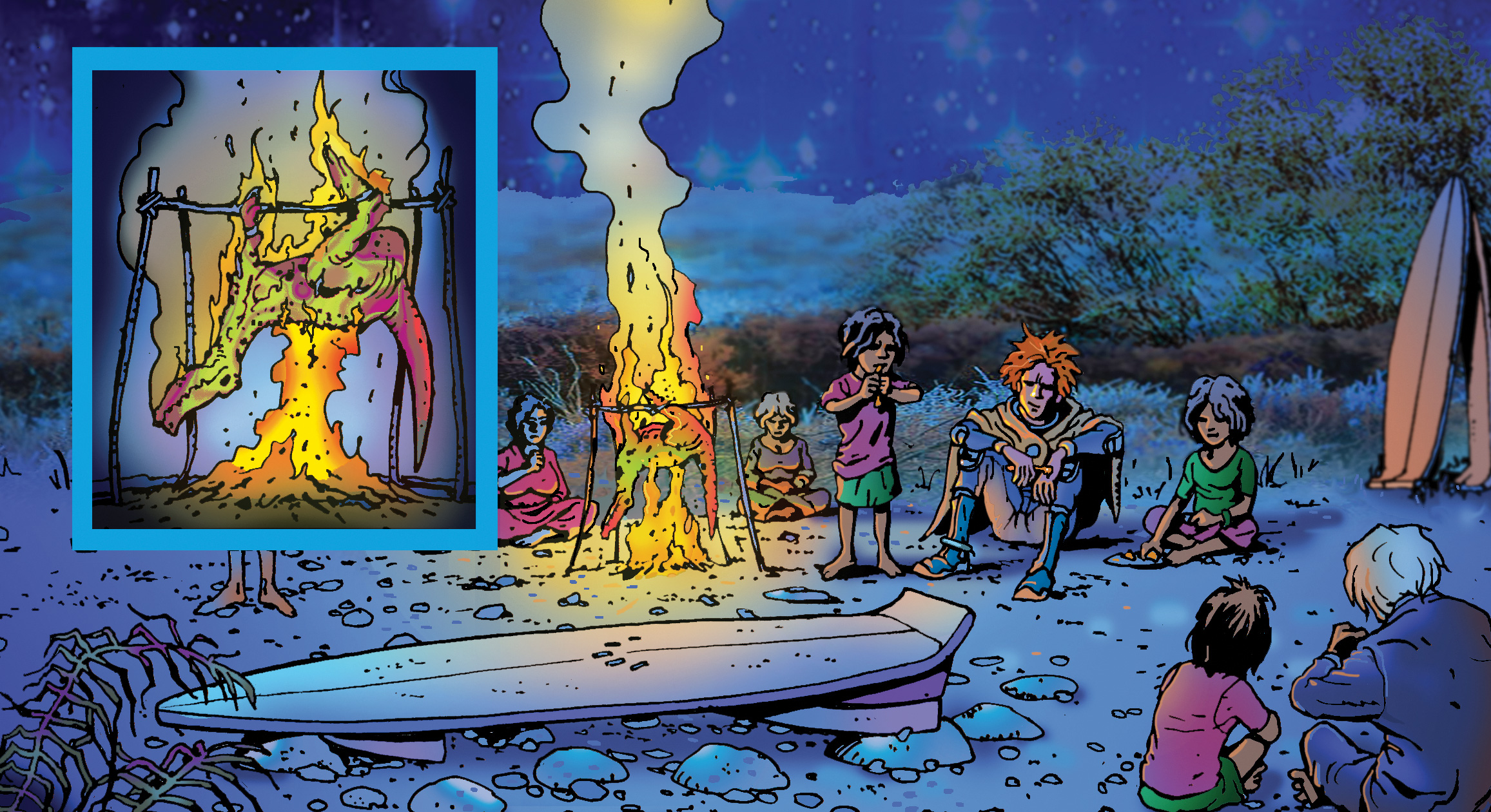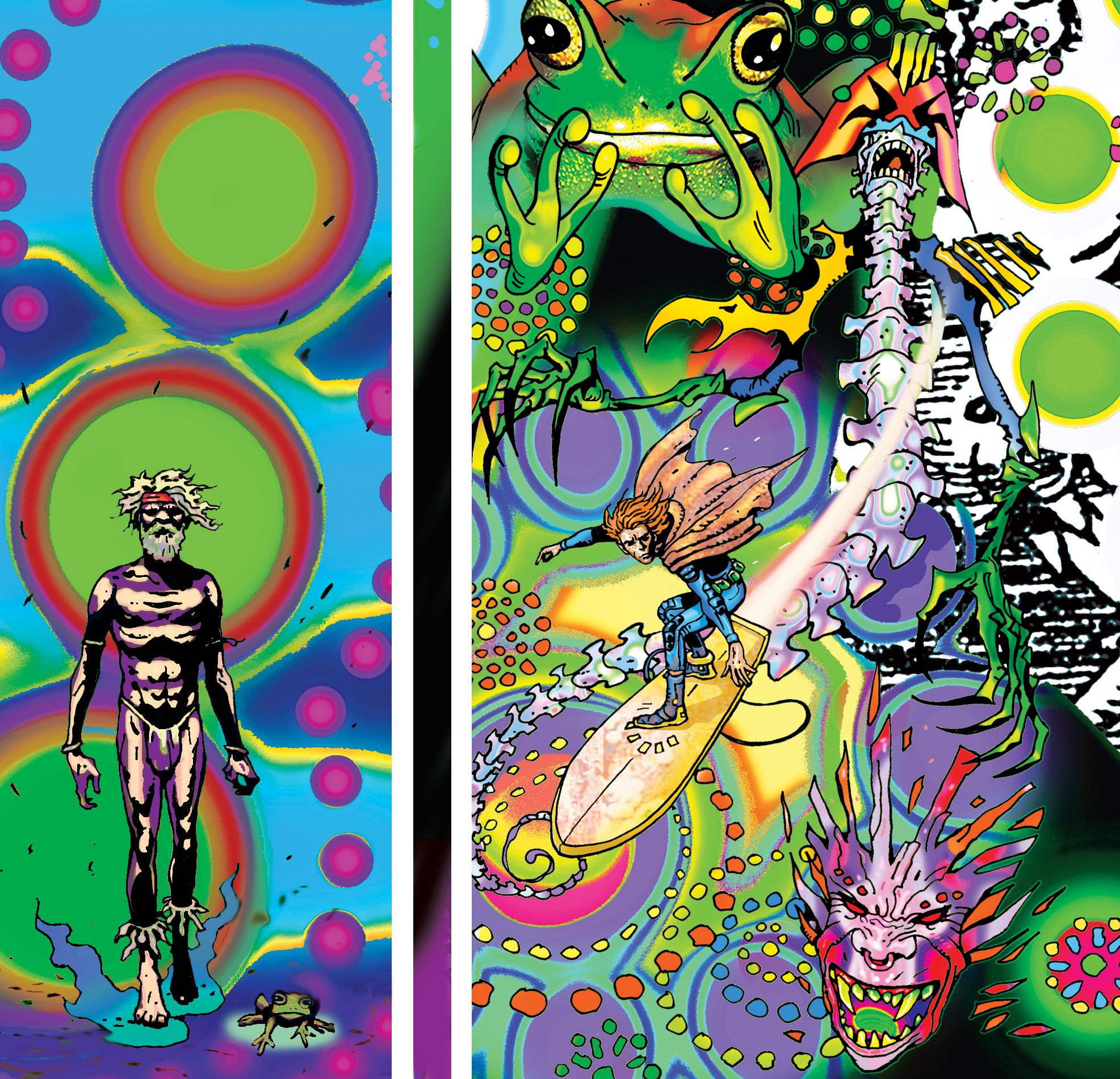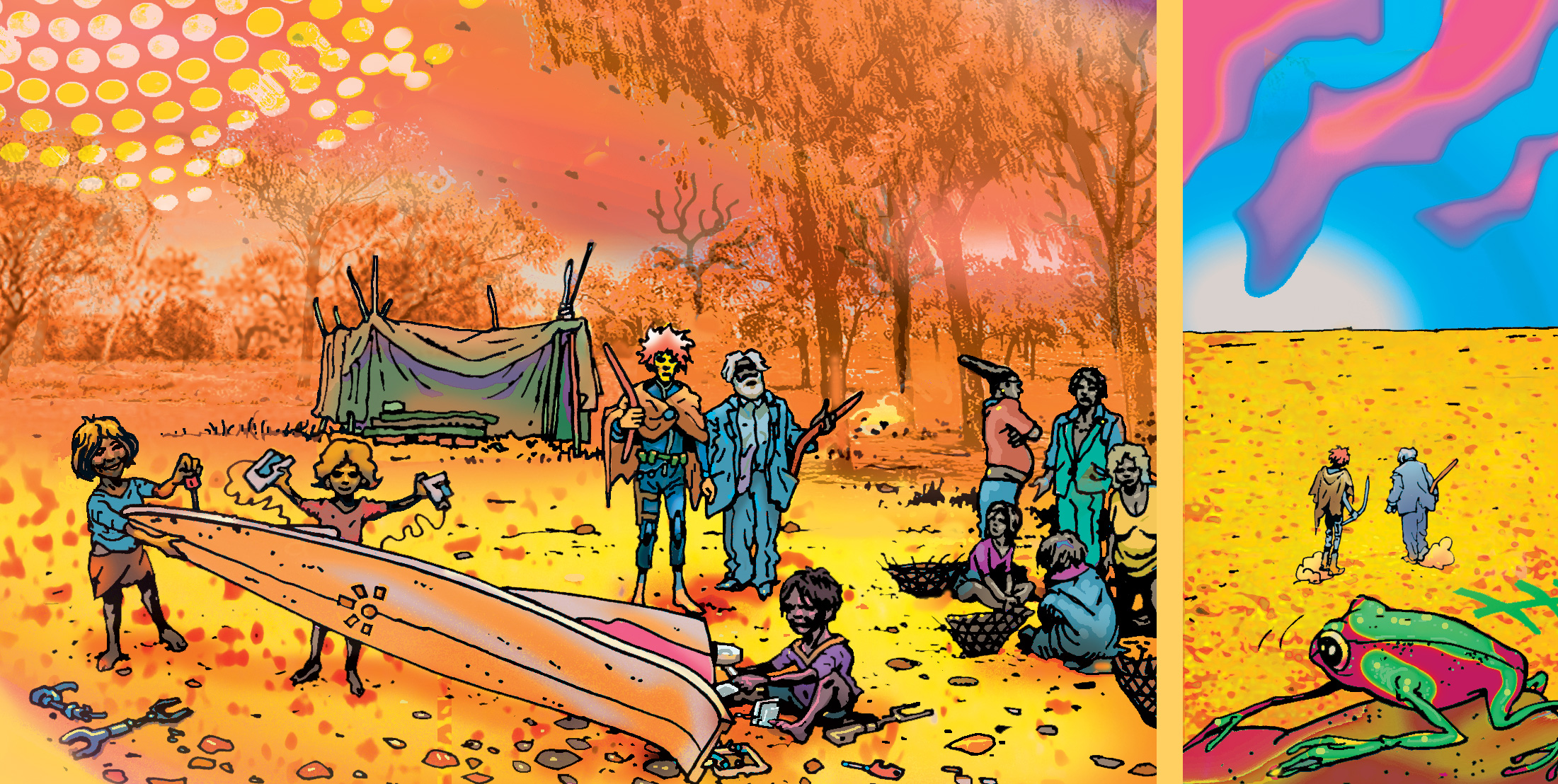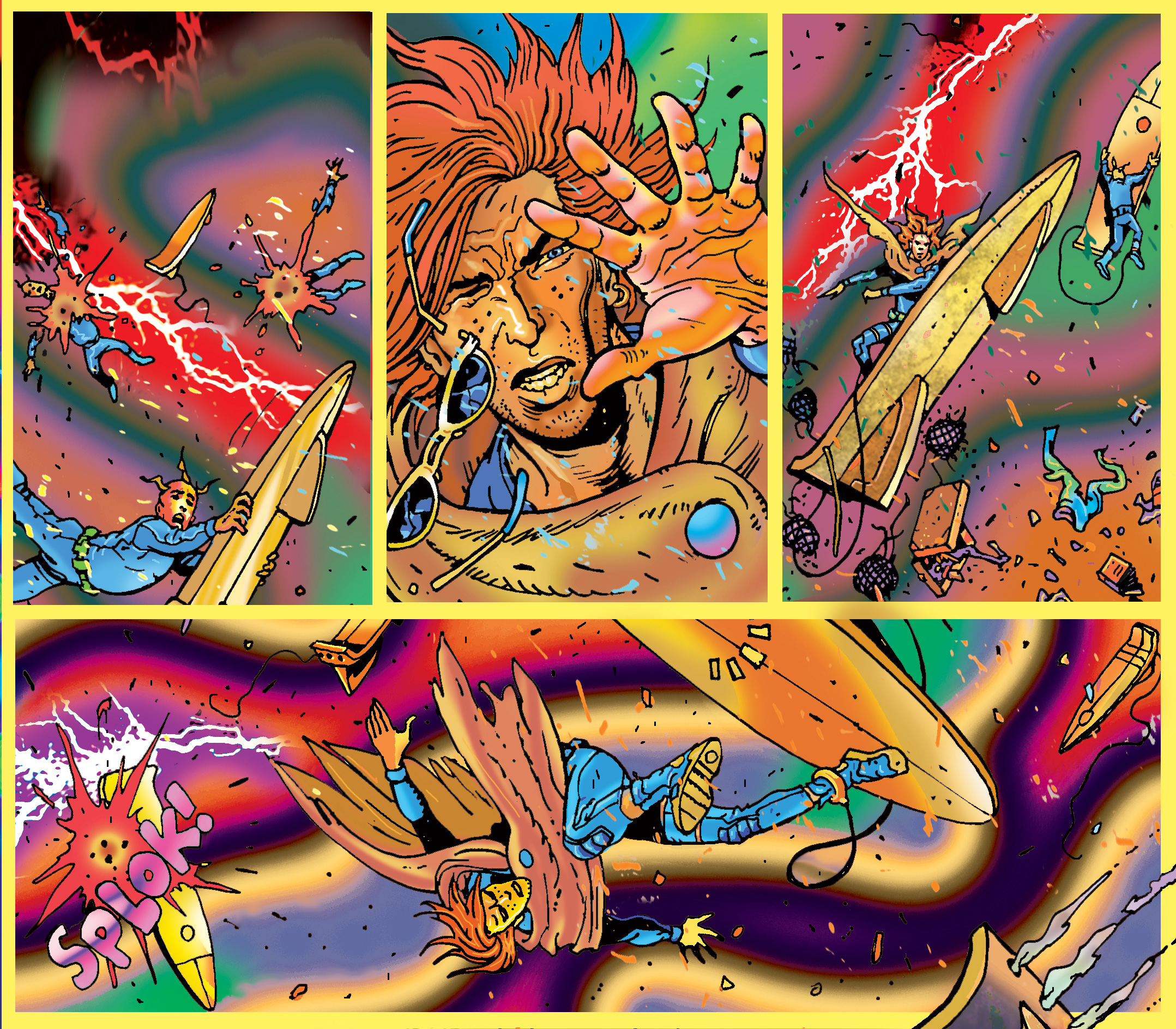INTERVIEW: the return of Chopper with David Baillie and Brendan McCarthy!
10th April 2018
Originally inspired by a 2000 AD fan letter signed off as “From Chopper”, John Wagner and Alan Grant created the wall-scrawling anti-establishment icon Marlon Shakespeare for the Galaxy’s Greatest Comic in 1981.
Since his first appearance in Prog 206, Chopper has gone from king scrawler of MC-1 to one of the all-time greatest skysurfers. And along the way, despite only appearing fewer than 100 issues of 2000 AD and the Judge Dredd Megazine, he’s become one of the most beloved and enduring of characters.
It’s now time to revisit Chopper, fourteen years after his last appearance, as David Baillie and Brendan McCarthy sing another song of the surfer. Richard Bruton asks the questions…
Richard Bruton: It’s been 14 years since we last heard from Chopper. He returns in Meg 395 with Wandering Soul. What can you tell us about the story?
David Baillie: Wandering Soul is a five-part story, each episode is ten heart-pounding pages long. All of the best Chopper epics come in at around the 50-page mark, which makes this the perfect length.
Our story is set in Oz’s scorching Radback, where Chopper’s been almost entirely on his own, surfing megathermals for the last few years. We have a whole new cast of characters for Chopper to ally himself with and rail against, although I found it impossible to resists a few cameos (and one almost-cameo). Chopper has befriended a nomadic Aboriginal tribe, whose travels have crossed his own a few times over the years. Normally when this happens it’s is a cause for celebration but something terrible happens this time – in the shape of a band of brutal mutant marauders, armed with a secret weapon from the history of Oz. It’ll take all of Chopper’s guile and strength to save his friends – and everyone else – from the evil that is unleashed.
In the long history of 2000 AD, Chopper has been a character that’s resonated incredibly strongly with the readers. What do you both think makes Chopper so popular?
DB: A lot of readers were about the same age as Chopper when he first appeared, and have aged alongside him in the intervening years. This probably helped us all really invest in the highs and lows of one of the most remarkable of any of Mega City One’s sons or daughters. From teenage graffiti artist, to cube resident, then ex-con on the run before becoming an international powerboard star – he might have only appeared in a couple of hundred pages but he’s done so much with that page-time! And if I’ve made Chopper’s life story sound plot-heavy, it hasn’t been at all. At times heartbreaking, almost always poignant – his has been an incredibly interesting journey. The story of a guy looking for some sort of meaning in his life, and the horrors he meets on the way.
Rather famously, in Prog 655, John Wagner effectively left Chopper dying after Supersurf 11 and the Song of the Surfer storyline. Garth Ennis revived the character for the first six issues of the Megazine back in 1990. And has gone on record as saying how big a mistake he thought it was: “Chopper was kicking about at the time. He had been pretty much shot to death in John’s story, Song of the Surfer. There’s no doubt about it, he should have been left there.” So, given that we have heard nothing from the super surfer since Big Meg by Wagner and Dylan Teague in 2004… What made you decide that now was the right time to bring him back?
DB: I’ve secretly harboured a desire to bring back Chopper for years now, but had never actually mentioned it to anyone. At last year’s 2000 AD 40th birthday bash con I was signing my name with a little Chopper happy face. After Wandering Soul was announced a fan tweeted to say that he’d cracked my code and had known all along what I was doing next. Which is brilliant as Tharg hadn’t even asked me at that point!
I think it’s fair to say that there have been a few mis-steps in the Chopper chronicles since Song of the Surfer. Before writing Wandering Soul I sat down and inhaled every page the character appears on (even a single panel mention in an Al Ewing story from a few years ago). Most of that re-read was sublime, but some of it is ever so slightly painful in places. I definitely disagree that bringing him back was a mistake – but you could argue that some of what happened afterwards may have been.
Chop’s very much alive and the job Brendan and I have is to make the next chapter of his saga as memorable and meaningful as those incredible early epics.
Given the unique conceit in Dredd, that the years pass in real time, this would make Marlon Shakespeare well into his middle age by now, given that he was a teen in his 1981 debut Un-American Graffiti. Thirty-seven years later, he’d be somewhere between 50 and 56. What does that mean for the strip? And is Chopper still surfing?
DB: Chopper’s never gonna stop surfing! Chopper has youthful genes, combined with his athletic pursuits and a simple lifestyle he’s aged very well. He’s not some creaky old geezer on a board when we meet him – but he’s also not Peter Pan. And of course no matter how well a body weathers, the years always change the person inside, and that’s absolutely the case with Chopper. He’s seen a lot, lived through an incredible amount of trauma and it’s all left marks, scars even, but that’s made him far stronger than even he knows. Wandering Soul is all about pushing him to the limit, showing both him and us exactly what he’s really capable of.
David, your 2000 AD strips to date have been short features, prose stories etc. Taking on a multi-parter featuring one of the truly iconic 2000 AD characters in Chopper is something of a great step up for you. How does it feel to have the weight of expectation upon you?
DB: I hadn’t really thought about the weight of expectation at all until all the tweets and requests for interviews came in after the announcement. One of the nice things about working in comics is that by the time all that stuff kicks in you’ve usually finished the work and so it’s not a consideration. The magnitude of the task wasn’t lost on me though. I set out to make this story be as close to the original Wagner epics in terms of style and quality as possible, while taking full advantage of the creative whirlwind talents of Brendan, and that’s no mean feat. I spent weeks reading and re-reading old stories, and doing loads of background research on Australian Aboriginal life, and the science and magic that appear in the story. It’s probably the longest I’ve ever taken to write fifty pages of comics but I was determined to do right by Chop.
Brendan, you’re following in the footsteps of such luminaries as Ron Smith, Cam Kennedy, and Colin MacNeil on Chopper. Is this something you consider in planning the artistic style, or will you be delivering the strip in pure McCarthy style?
Brendan McCarthy: I’m drawing the strip in a style suitable to the story requirements, invoking Aborigine designs which is line with the Australian ‘Radback’ setting. It’s been fun to get into the Oz judges again, a branch of the Judge culture that I originally created way back when.
Over the years, your artwork has graced so many of the characters in 2000 AD, as well as featuring your own, unique creations. Any preference to established characters versus new strips?
BM: After seeing the recent big hardcover collection of my Dredd strips, I thought it would be fun to do some new material set in Dredd’s world — hence the Hoverods two-parter. I called Tharg up one day and suggested a story set in the Oz Radback and so we cooked up this Chopper story. But I like to create my own new characters and worlds too.
Your last major work for 2000 AD was 2012’s Zaucer Of Zilk, with Al Ewing, a fabulously enjoyable, totally over the top experience. Any thoughts on bringing that back at some point for a second series?
BM: I’ve had a few chats with Al about a new Zaucer strip and we’re open to it, but it’s mainly scheduling. Al is a very busy writer at Marvel, so it’s finding a time where we both have availability. I’m sure it’ll get done at some point. The strip worked well, particularly in the US collected IDW edition, where American readers seemed to take to its unique British, Tim Burtonesque sensibilities. It may have been a bit too fabulous for the hard sci-fi sensibilities of some 2000 AD readers! Still, it was something different and there is a tradition of more bizarre and surreal stories, like Hewligan’s Haircut and Shaky Kane’s stuff.
The return of Chopper isn’t your first post apocalyptic surfing story either, with yourself and Peter Milligan creating Freakwave. And if I’m right in my dates, this would have been early 80s, finally seeing publication in Strange Days, 1984. This was actually before Chopper took up the board himself in 1986’s Midnight Surfer tale by John Wagner, Alan Grant, and Cam Kennedy. Olde Tharg-lore would have it that the Oz storyline was suggested by your good self.
BM: The idea for Chopper as a flying surfer originated from a trip I made to Australia about 35 years ago and later, upon return to rain-sodden Blighty, I approached John Wagner about doing a sunny Australian-based Dredd strip. And that’s what John came up with.
Over your long career, you’ve worked with so many talented writers and artists, and worked in many different fields. This includes a massively successful career as a designer and storyboard artist on various film and animation projects. Most recently, and most successfully you not only designed but co-wrote 2015’s Mad Max: Fury Road. Now, with Hollywood calling, and a massive hit like that to your name… what is it about comics that keeps pulling you back?
BM: Hollywood can waste a massive amount of your time through projects getting derailed and canned… It happens all the time and is very frustrating, as years can go by with nothing concrete to show for your time. Obviously, when it hits, it hits big, as in the case of Fury Road and the original Ninja Turtles movie. Out of nowhere about 10 years ago, DC Comics called me up and asked if I’d like to do the final issue of their prestige Artist’s series SOLO. That rekindled my interest in comics and in getting stories out to the public. I had a backlog of comic ideas, and after doing the FEVER series for Marvel, I approached 2000 AD with the Zaucer idea. Tharg put me in touch with Al Ewing and we figured out The Zaucer of Zilk story. After that I did a creator-owned graphic novel for Dark Horse called Dream Gang which I wrote and drew. I like to mix up my own stories and then draw other people’s characters for a while. I’m writing a new thing at the moment, in between drawing Chopper.
What are your backgrounds in comics? Both reading (first experiences) and getting into comics?
DB: Reading newsprint Marvel UK reprints of Stan and Jack comics in the ’80s are among my earliest memories, then collecting coins found down the back of the couch to buy this week’s Spider-Man before I was old enough to get pocket money. I discovered 2000 AD in my teens and spent many, many weekends scouring boot sales and second hand markets around West Lothian and Glasgow hunting down old Progs, often almost breaking my back carrying hundreds of them home at a time. I always wanted to make comics but it honestly seemed like an impossible dream for a working class boy in a Scottish mining town. I probably don’t need to to describe my career advisor’s face when I told him my ambitions. It wasn’t until I was nearly twenty that I met people who’d actually managed to create comics, self-publishers and people who’d worked for 2000 AD and in the US. I eventually started out as an indie cartoonist at the turn of the millennium, writing, drawing, folding and stapling my own mini-comics and then hand selling them at conventions. (I vaguely recall writing a few Megazine columns about this, actually…) From there I was determined to emulate the career path of my heroes – working for 2000 AD and then Vertigo. Which finally came to pass, although it took a bit longer than I’d wanted it to. Now having achieved everything I ever dreamed of I can rest easy.
BM: Grew up reading them, and writing and drawing them in the back of school exercise books. Got serious with Valiant comic and The Steel Claw, Dan Dare, Frank Bellamy and then the ’60s Marvel and DC. A similar trajectory to many creators who later went on to fame and fortune. I was recently noting the amount of comic book people who have made a big impression on the wider entertainment industry. We really are taking over the world… I read Yarooh! at an impressionable age, the Billy Bunter-inspired underground comic, which printed stories featuring lots of jolly good thrashings and the stealing of Jammy Dodgers from the school tuck shop. This led to an intense ambition to draw The Bash Street Kids, an aspiration I’ve yet to fulfil, sadly. I once cooked up a surreal ‘school days’ script with Sir Grant Morrison called School For Fools, which is yet to see the light. Fo’ real.
You can catch up with the complete adventures of Chopper in Judge Dredd: The Complete Case Files #4, #9, #11, and #12. And he appears in his own collection, Surf’s Up, featuring the magnificent Song Of The Surfer.
Chopper: Wandering Soul begins in Judge Dredd Megazine #395, out on 18th April!

